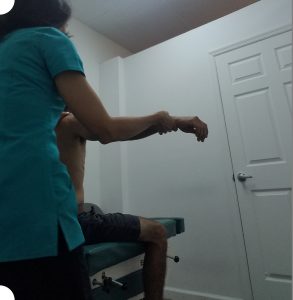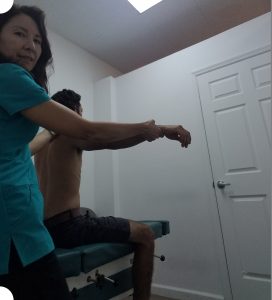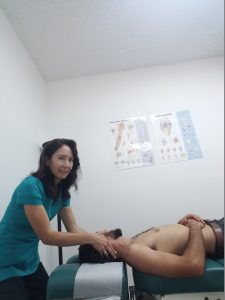
This is a follow up to the post Various Soft Tissue Manipulation Along With Chiropractic Care: part 2. As a review, soft tissue manipulation (STM) techniques are defined as those physical methods applied to muscles, ligaments, tendons, fascia, and other connective tissues with the goal of therapeutically affecting the body. This post is about body wall reflex techniques which are also a form of soft tissue manipulation technique. Read below about the Various Soft Tissue Manipulation Techniques Along With Chiropractic Care: part 3 on Body WALL REFLEX TECHNIQUES (acupressure, chapman reflexes) practiced in our West Palm Beach office.
BODY WALL REFLEX TECHNIQUES
Body wall reflex techniques incorporate a number of different procedures for identifying a wide variety of different types of soft tissue points that are sensitive to palpation. Palpation is the process of using one’s hand or fingers to identify a disease or injury of the body or the location of pain. Basically, the soft tissue point is found via palpation for treatment.
The presence of these body wall reflex points are explained by a reflex pain mechanism. So if you’re in pain, your neurons (nerve cells) send a signal or impulse. This impulse travels to your spinal cord, your thalamus and then your brain. Then you recognize the pain. And with prolonged pain there are many impulses creating a vicious cycle which spreads through your spinal cord to your brain. This is called the internuncial pool connection (internuncial neuron connects two other neurons). These connections go upward, downward, and across the spinal cord, potentially reaching the thalamus. Your thalamus relays motor and sensory signals to the cerebral cortex.
Presence of Pain at a Distance from the Site of Injury
Finally, depending on the extent of these connections, it is possible to detect the presence of pain at a distance from the site of injury and sometimes on the other side of the body. Moreover, even sympathetic disturbance can be present at this distant site. Sympathetic disturbance is when your sympathetic nervous system directs the body’s rapid involuntary response to dangerous or stressful situations. For instance, a flash flood of hormones boosts the body’s alertness and heart rate, sending extra blood to the muscles.
These reflex points are in fascial tissue (thin connective tissue that surrounds organs, blood vessels, bones, nerve fibers and muscles). Similarly, these reflex points seem to be responses to a variety of types and degrees of tissue injury, including physical trauma, infection, degeneration, and chemical injury.
In mapping out where these body wall reflexes exist, there is much overlap of the various body wall reflexes. This suggests that each developer recognized a similar characteristic, but explained it differently. Examples of these are acupuncture points, Travell (trigger points), Chapman (lymphatic reflexes), and Bennett (vascular reflexes). Although there are a number of different names with different philosophical views, many procedures are very similar in application.
Acupressure Point Stimulation
Acupressure is a method of manual point pressure applied to acupunture points for producing analgesia (insensibility to pain). Acupuncture points are organized along meridians that have no known neurologic or vascular pattern. There appears to be a measurable change in electrical potential in acupunture points. Treatment is by electrical stimulation, needle application, or manual (by hand/finger) pressure. In theory, blockage or other dysfunction in the meridian causes illness.
In one study acupressure was studied for effectiveness in reducing nausea and vomiting of pregnancy. The results indicated that acupressure was effective in reducing symptoms of nausea but not frequency of vomiting in pregnant women. However, promising results exist demonstrating efficacy of acupuncture/ acupressure in adult postoperative and chemotherapy nausea and vomiting.
Firstly, acupressure has an effect on pain reduction through the modulation of endorphin (hormones for pain relief) levels. Secondly, through stimulus-produced analgesia by working on local mechanoreceptors (sensory cell that responds to mechanical pressure or distortion) and nociceptors (sensory receptor for painful stimuli). Thirdly, the nerve reflex theory of acupuncture says that when an abnormal condition occurs in an internal organ, alterations will take place in the skin and muscles related to that organ by means of the nervous system. Interestingly, there is a 70% correlation between trigger point maps and acupuncture point charts.
Chapman (Neurolymphatic) Reflexes
Chapman reflex points are found in the deep fascia and are associated with specific viscera (organs). These reflex points can be used as a diagnostic aid (diagnosis of illness) to locate a pathologic (indicative of disease) change. Also, these reflexes influence visceral function through nervous system input. Finally, these reflexes are useful for influencing the motion of fluids, mostly lymph. And for influencing visceral function through the nervous system.
There was a study determining whether stimulation of a chapman reflex point could reduce blood pressure. They found while there was no effect on blood pressure, there was an alteration in aldosterone levels. Aldosterone affects the body’s ability to regulate blood pressure. Many hypertensive patients have high aldosterone and low renin levels affecting the renal tubules and causing sodium retention. Hypertensive patients have shown abnormalities in aldosterone levels. Stimulation of chapman reflexes caused a consistent lowering of aldosterone levels. It was suggested not enough time was allowed, because even with drugs that lower aldosterone, it takes 5 to 7 days for the blood pressure to lower.



Soft tissue manipulation techniques along with chiropractic adjustments has many benefits for your health! Call your West Palm Beach chiropractor at 561-253-8984 to make an appointment today.
Find out more about Various Soft Tissue Manipulation Techniques Along With Chiropractic Care: Part 3 in the next post (part 4) on BODY WALL REFLEX TECHNIQUES (ischemic compression).
References:
Bergman, Thomas. Peterson, Lawrence. Chiropractic Technique Principles and Procedures
- Third Edition
Hammer, Warren. Functional Soft Tissue Examination and Treatment by Manual Methods.
Third Edition
Meiri Chiropractic
561-253-8984